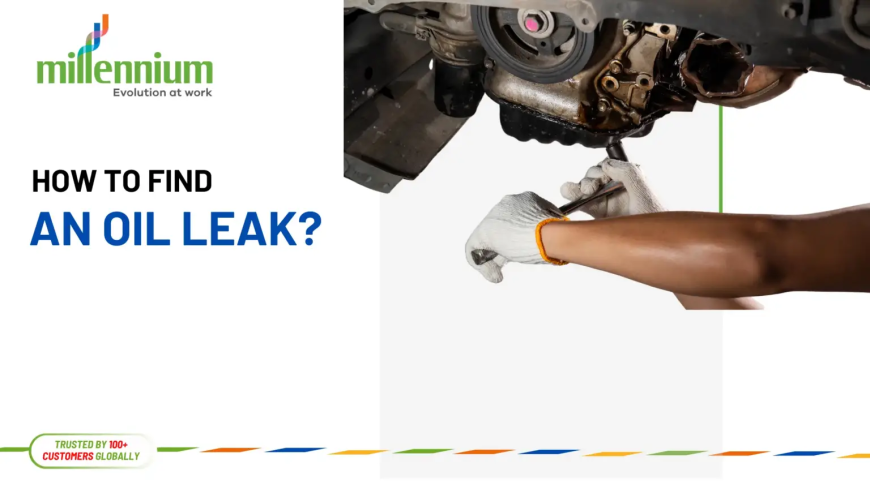How To Find An Oil Leak
Oil is the lifeblood of your engine, ensuring smooth operation, reducing friction, and helping control temperatures.

Oil is the lifeblood of your engine, ensuring smooth operation, reducing friction, and helping control temperatures. When your engine develops an oil leak, even a small one, it can escalate into major problems if ignored—damaging internal parts, lowering efficiency, and shortening the lifespan of your vehicle. Whether you’re a seasoned car owner or a first-time driver, understanding how to spot and fix an oil leak is essential to maintaining your engine’s health and performance.
Signs of an Oil Leak in Your Engine
One of the first challenges is recognizing that there’s an oil leak to begin with. Oil doesn’t always leak in obvious puddles under the car—sometimes, the symptoms are more subtle.
A sudden drop in oil level on your dipstick without any clear reason is often a red flag. If you're regularly topping off oil between scheduled changes, there's a chance that some of it is escaping. Keep an eye on the oil level at least once every couple of weeks, especially if you drive frequently or under harsh conditions.
Another signs of oil leak in engine is the smell of burning oil while driving or shortly after turning off the engine. This happens when leaking oil drips onto hot engine parts, such as the exhaust manifold. You might also notice faint smoke rising from under the hood, or a slight haze behind your vehicle when accelerating.
Oil leaks can also trigger warning lights. If your oil pressure warning light illuminates, it could be due to insufficient oil caused by a leak. While not every light means there's a leak, it definitely warrants a closer look.
Don’t overlook stains on your driveway or garage floor. These may appear as dark brown or black spots. If the stains are fresh and appear regularly after parking, an oil leak is likely.
How to Detect an Oil Leak
Once you suspect a leak, the next step is identifying its source. Start with a visual inspection. Let the engine cool, then pop the hood and shine a flashlight around the engine bay. Check common leak points such as the valve cover gasket, oil pan gasket, oil filter housing, front crankshaft seal, and around the dipstick tube.
Next, slide under the vehicle and inspect the underside. Look for oil accumulation on the oil pan, near the drain plug, or around the transmission bell housing. Even if there’s no active drip, oily residue can be a sign of seepage.
If the leak isn’t obvious, you can take your inspection a step further with a degreasing method. Clean the engine and surrounding components thoroughly with a degreaser, then drive the car for a short time. Reinspect the engine afterward. Fresh oil will clearly mark the point of the leak.
A more advanced method involves using UV dye. This dye is added to the engine oil, and after a short period of engine operation, a UV flashlight is used to track where the dye appears. This method can help pinpoint leaks that are hidden deep within the engine compartment or in areas not easily visible.
How to Fix an Oil Leak
Fixing an oil leak depends on the source and severity. For basic issues like a loose oil filter or drain plug, tightening or replacing the part is a straightforward solution. Always ensure you're using the correct torque specifications to avoid overtightening, which could strip threads or damage seals.
If a gasket is the culprit—such as a valve cover or oil pan gasket—it may need to be replaced. This involves removing the affected part, cleaning the mating surfaces, and installing a new gasket or seal. While some gaskets are accessible for DIYers, others may require more disassembly and professional tools.
In some cases, the leak may be caused by a worn-out oil pressure sensor or a cracked engine component. Replacing the faulty sensor or using high-temperature epoxy for minor cracks may stop the leak, but more serious damage may need professional attention.
For temporary relief, oil stop-leak additives can help swell old seals and slow down minor leaks. However, these are best used as short-term solutions—not permanent fixes—especially for older vehicles or while waiting for parts or service.
Preventing Future Oil Leaks
Prevention is the best way to avoid the stress and cost associated with oil leaks. Regular maintenance is key. Stick to a consistent oil change schedule and always use the manufacturer-recommended oil grade and type. Old, dirty oil can become corrosive and lead to seal deterioration.
Inspect seals and gaskets for early signs of wear during routine maintenance. Even if they’re not leaking yet, small cracks or hardening rubber can signal that a replacement is due soon. Keeping your engine clean also helps—dirt and grime can hide small leaks, allowing them to go unnoticed until they become major issues.
Make sure your crankcase ventilation system is functioning properly. A clogged PCV (positive crankcase ventilation) valve can cause internal pressure to rise, forcing oil past gaskets and seals. Replacing the PCV valve periodically ensures that your engine stays properly ventilated.
Be cautious with how you tighten components. Over-torquing bolts, especially around the oil pan or valve cover, can damage gaskets and cause leaks to develop. Use a torque wrench and follow recommended specs during any DIY repairs.
Lastly, keep an eye on the engine’s cooling system. Overheating can cause thermal expansion and contraction that weakens seals over time. Maintaining proper coolant levels and ensuring your radiator and fans are working correctly can indirectly protect against oil leaks.
By understanding the warning signs, knowing how to spot the source, and taking proper steps to fix and prevent oil leaks, you can significantly reduce your risk of unexpected engine trouble. A proactive approach not only protects your engine but also saves time and money in the long run.

 divyaseo
divyaseo